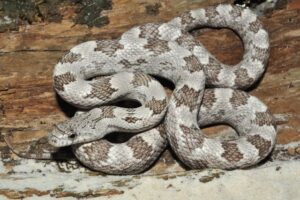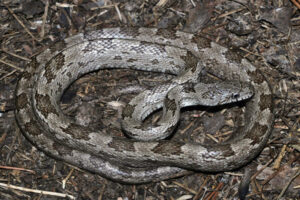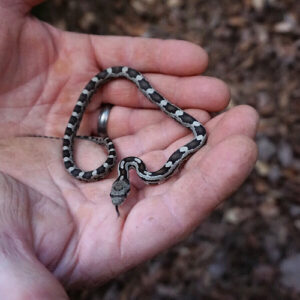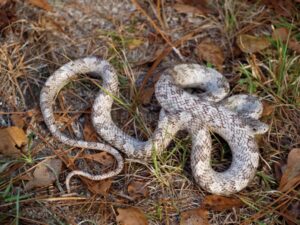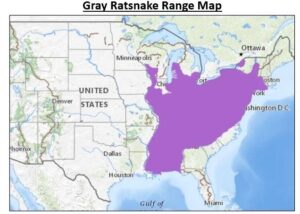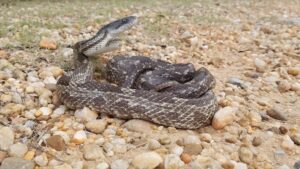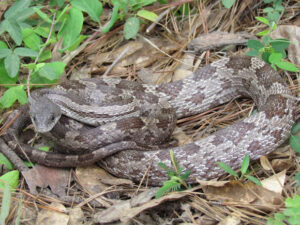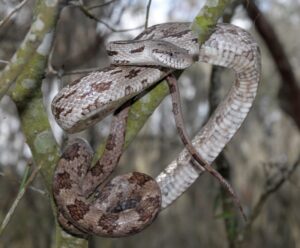The gray rat snake or gray ratsnake, also known by the names chicken snake, central ratsnake, pilot black snake and midland ratsnake, is endemic to North America. The medium to large snake is one of the ten ratsnake species in the American ratsnake genus of Pantherophis.
Scientific Classifications
- Suborder:Serpentes
- Family:Colubridae
- Genus:Pantherophis
- Species:P. spiloides
Conservation Status
Description
Size
The adults are of a total size 3.25-6.00 ft (99-183 cm), including the tail. The maximum recorded length is 8.10 ft (247 cm)
Color and Appearance
The juvenile pattern of dark elongate dorsal blotches separated by 4 or more pale gray body scales, a light gray crown with dark stripes forming a front-facing spearpoint, and a solid band covering eyes, extending backward to the posterior labial scales, are all retained in the adults in the southern part of the range. However, in the northern part of the range, the snake is black in adulthood with the juvenile pattern completely disappearing. The pale gray or off-white belly has darker, irregular blotches with a double row of black spots behind the divided anal plate. The dorsal scales at the midbody are weakly keeled.
Are They Dangerous to Humans
The gray ratsnake is not aggressive and avoids direct contact with humans. When startled, it stops on its tracks and remains still, holding its body in a series of wavy kinks. It also rattles its tail against the surface it is on, making a buzzing sound. It defends itself by raising its head and pretending to strike.
If handled, it musks its attacker with foul-smelling contents of its cloaca and bites if it feels the need. But it is less likely to bite than the other species of its genus. Wounds created by its bite are minor and usually don’t require anything more than a small bandage. But still, being a snakebite, it should be given medical attention.
Gray Rat Snakes at a Glance
Distribution
The gray rat snake is commonly found in the forests of the central and eastern US. It occurs almost continuously throughout a major part of the eastern half of the United States. Its range extends along the western edge of the Appalachian Mountains, from the southwestern part of New England to the Gulf of Mexico, northward from northern Louisiana to southwestern Wisconsin, and westward to the Mississippi River.
In Canada, it occurs in two disjoined regions of southern Ontario – the Great Lakes or St. Lawrence region in the southeast and the Carolinian forest area along the north shore of Lake Erie in the southwest.
Habitat
The agile climber can be found from the ground to the tree tops in different types of hardwood forests and cypress stands, along tree-lined fields and streams, and even around sheds and barns close to people. In its range, almost any environment rich in rodents, and with vertical escape options turn out to be suitable habitats for the ratsnake.
Lifespan
They live for 10-15 years, with a record of 25 years for a pet gray rat snake.
Predators
Larger carnivores like egrets, hawks, and foxes are its predators.
Diet
The powerful constrictor and scent-hunter mainly eats birds, bird eggs, and small mammals. Neonates and juveniles have lizards and frogs in their diet.
Reproduction
Oviparous (lays eggs that hatch outside the body)
The females reach sexual maturity at 7-9 years of age and breed from April to July. 5-27 eggs are laid around mid-summer that hatch into 9.8-11.8 in (25-30 cm) long hatchlings in September.
Care Sheet
Size of the Enclosure: The babies can be housed in shoebox-sized enclosures. The size should be increased as the snake grows.The adults need 55-gallon tanks.
Temperature: A temperature gradient of 72-82°F should be maintained inside the tank.
Humidity: 30-70% humidity is ideal for the pet setup. A large pan of water should be kept inside the tank.
Substrate: Ideal options for substrates are aspen bedding and aspen bark. Smooth rocks and sand of the same color as the pet can also be provided for it to hide.
Feeding: It should be given size-appropriate meals of mice, insects, frogs, rats, and lizards.
Source
i.pinimg.com, inaturalist.ca, reptilesmagazine.com, birdwatchinghq.com, alabamawildlife.org, lh3.ggpht.com, a4.pbase.com

